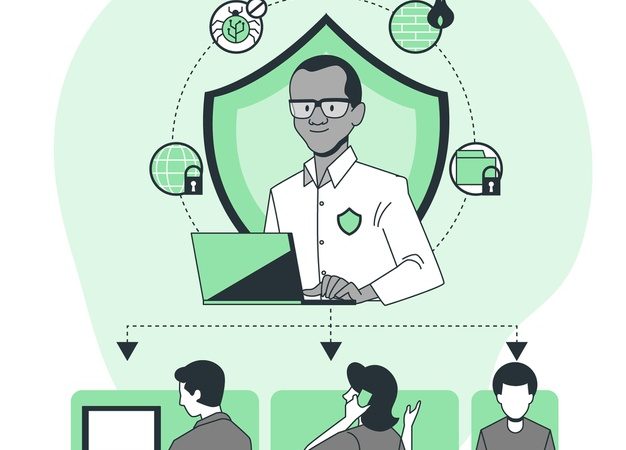The Best 9 M4ufree Alternatives For Streaming TV Shows And Movies For Free
Barsha Bhattacharya, 7 days ago

Barsha Bhattacharya, 7 days ago

sibashree bhattacharya, 1 week ago

Barsha Bhattacharya, 1 week ago

Barsha Bhattacharya, 1 week ago


With businesses relying a lot on handheld or digital devices, the need for security measures is rising profusely. Endpoint security is one such practice that secures entry or endpoints of digital devices such as desktops, laptops, and mobile phones.
With evolving malicious threats, businesses are readily adopting modern measures and replacing age-old software security software with endpoint security solutions. Endpoint security systems protect the endpoints on a network or in a cloud from cybersecurity threats.
Is that all? Keep scrolling and learn more.
Endpoint security is the practice of securing digital devices such as desktops, laptops, and mobile phones from cyberattacks and malicious threats.
This software allows businesses to protect their devices which their employees use for servers or work purposes that are either in the cloud or on a network from cyber threats.
Right now, this threat is increasing, and hackers are launching a cyberattack every 39 seconds. Endpoints are the most common targets, considering people use them to connect to the network.
With this, technology has evolved from antivirus software security to endpoint security to fight the evolving sophisticated malicious activities.
Endpoint security works by examining the files as soon as they enter the network. The endpoint protection platforms give system administrators a centralized console that is installed on a network gateway. This allows cybersecurity professionals to keep track of each device individually.
The client software is attached to endpoints (either as a SaaS that can be managed remotely or directly on the device). Once the endpoint is set up, the client software can push updates to the endpoints when required, authenticate log-in attempts from each device, and supervise corporate policies from one location.
Luckily, with this, sophisticated threats like polymorphic attacks, file-less malware, and zero-day attacks fail to cause any harm. Continuous monitoring allows the EDR to offer better visibility and better response options. Moreover, EPP solutions are available in on-premises and cloud-based models.
Undoubtedly, cloud-based products are more scalable and can easily seep into the current architecture. Certain regulatory rules or compliance rules still agree on an on-premises platform. In case you want to understand this thoroughly, you can contact the IT support helpdesk which has expertise in handling security threats and the solutions to cope with reliable platforms or different security systems.
Many potential threats are rising with time and make the IT giants feel the urgent need for endpoint security. For instance,
Due to the aforementioned two risk factors, endpoint security has become extremely crucial for any company.
There are many components of Endpoint Security. These include:
Until now, you must have realized the advantages of Endpoint security over other modes of security. Some of the most advantageous aspects are:
It gives protection against trojans, file-based, file-less script attacks, malicious JavaScript, a VBScript, PowerShell, and other macros. All these mentioned viruses can harm your device, so an endpoint is necessary to save your data.
Endpoint fulfills the purpose by preventing the necessary remediation of malware-filled devices, protecting trade secrets, aiding device performance, and preventing ransomware attacks.
It saves your time by freeing up IT staff or managed service providers to focus on the company’s primary objectives. It also ensures uptime for all devices and reduces the risks of any other potential online threat.
Since many companies are governed and managed by data security regulations which require special precautions against the stealing of data such as retail, healthcare, and public sectors, etc.
Companies are now relying more and more on data; thus, protecting data from external and internal threats is very important. Cybersecurity is also a reliant platform, but endpoint security is considered the perfect choice for data protection.
Endpoint security protects all those devices that connect to the network from attacks, like smartphones and laptops. It works in different ways, and let’s have a look at that.
A centralized management console enables employers to take charge of the security of all the devices that are connected to their network. And this includes administering policies, installing software, and pushing updates.
Administers can restrict access to the network depending on the compliance of the device with its security policy. Moreover, they can also install some security devices directly on the device to monitor it and protect it when needed.
Endpoint security prevents users from accessing unsafe or unauthorized applications.
They use encryption to prevent any kind of data loss.
It can detect malware and other security threats. Moreover, it is capable of monitoring user behavior and flags any kind of unusual activity.
This is inclusive of full-disk encryption and secured file management.
It also regulates USB devices and any other external device access to prevent any and all kinds of unauthorized data transfer.
Some of the top challenges of endpoint security include:
Insider threats: This is a major threat to endpoints as malware can easily enter a device when a user clicks on a web link or a malicious email.
Ransomware: This is another great threat to network security, as ransomware attacks cause huge financial losses.
Data loss: As per data from statistics, 64% of the respondents name data loss as one of the biggest cloud security concerns.
Information privacy: When connected to a device, it can transfer data in real time. Additionally, they can hack personal data if the connection is not secure.
DDoS attack: A distributed denial-of-service attack is another malicious activity that targets to disrupt the normal operation of the network, server, or service.
Device management: It is not easy to keep all the devices tested and updated. More so when there are thousands of devices in an organization.
To protect the infrastructure, resources, and data of the organization, it is important to implement a few effective endpoint security or protection programs. To start with, here are some of the best practices.
Installing firewalls, antimalware, and antiviruses can identify and block threats. To fix these known vulnerabilities, you have to regularly update and patch operating systems and software updates on all the devices. Moreover, implement a policy that restricts the use of unauthorized software and devices.
Educate your employees, make them aware of the phishing attacks, and train them so they do not click on any suspicious links. Set up a clear procedure for reporting any kind of suspicious activity they find, and conduct regular audits to stop potential misuse.
Make sure people are doing the basics, kike having a strong password and a multi-factor authentication process.
As remote work and hybrid work environments rise, encryption acts as a protection layer for sensitive data both in transit and at rest.
Threats are always evolving, and it is needed that you stay updated about the latest vulnerabilities and threats. Make sure you have a threat intelligence. You can have a trusted source, or you could attend security workshops and lean on some security vendor to keep you informed about the latest trends.
Endpoint activities need to be monitored for suspicious behavior. As you identify the potential threats, address them accordingly. Also, try to adopt some EDR or endpoint detection and response tools. They offer real-time solutions to threats and help you identify and respond to those.
Endpoint security tools allow organizations to look into complex and frequent attacks, as they provide visibility and detection across the endpoints. Here are some of the different types of endpoint security tools and solutions mentioned.
EPP solutions bring together different types of functionalities like firewalls, application control, and antivirus into one common suite. They act as a protection against ransomware, malware, and viruses.
This one goes beyond the traditional antiviruses, monitors endpoints for investigating potential threats and suspicious activity, and arms you with the tools that you need for remediation and response.
They provide a broader view into the data that has been collected from different security tools across cloud, identity, network, and endpoint. They offer a more comprehensive picture of the upcoming threats and promote effective threat remediation.
This one is known for managing various product categories and often numerous products. They take over the basic cybersecurity tasks, ensuring the product operates correctly. They also review alerts that the product generates, perform analysis, and forward it to the internal team.
This often acts as a custom-build detection and response, leveraging products with the security and operation team of the vendor. They deliver the detection along with the response capability which otherwise you have to build internally.
This is specifically designed to protect mobile devices like tablets and smartphones, and this solution enforces security policies, tracks their activities, and monitors mobile-specific threats and misconfigurations.
When you are choosing an endpoint security tool, there are certain things that you have to keep in mind. Here are those mentioned.
Needless to say, endpoint security is coming out as a front-runner when it comes to solutions concerning data protection. Running a company is not easy; hence, having a reliable platform for securing your most important asset, i.e., Data, is extremely crucial. It is better to stay aware of all the related aspects of Endpoint security as it will make you understand things in a more crystallized manner.
Read Also:
Abdul Aziz Mondol is a professional blogger who is having a colossal interest in writing blogs and other jones of calligraphies. In terms of his professional commitments, he loves to share content related to business, finance, technology, and the gaming niche.

Barsha Bhattacharya, 7 days ago

sibashree bhattacharya, 1 week ago